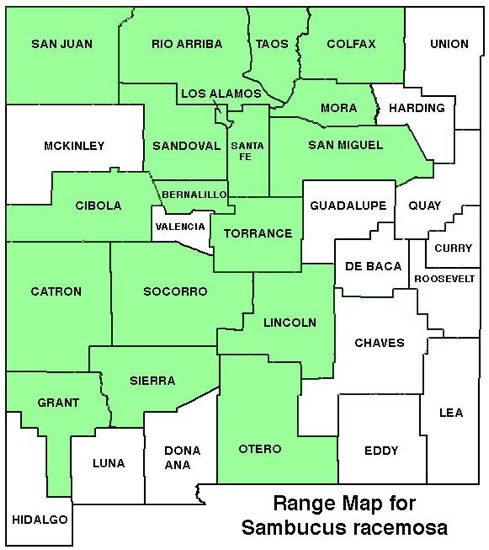WILDFLOWERS OF NEW MEXICO

From 3–16 feet tall (1–5 m), this multi-branched shrub or small tree has pinnate leaves with toothed leaflets. Note the showy, pyramidal clusters of small, white flowers, and small red berries. Unlike, Blue Elderberry, the red berries are considered toxic.
FLOWERS: March–July. Dense, upright clusters 1 5/8–4 inches long (4–10 cm), pyramidal to rounded with a strong ventral axis,; flowers have 5 creamy white lobes spreading open to 1/4 inch wide (6 mm); fruit berry-like, round, bright red, fleshy, 1/4 inch diameter, (6 mm).
LEAVES: Opposite with stalks (petioles), pinnately compound; blades 5–7 inches long (13–18 cm) with 5–9 leaflets, each elliptic to lance-shaped, 1–5 inches long (3–13 cm) by 3/4–3 inches wide (2–8 cm); edges serrated, top surface smooth to sparsely hairy; bottom pale, smooth to short-hairy; tips tapered.
HABITAT: Forests, meadows, slopes, riparian, disturbed areas; ponderosa pine-Douglas fir, spruce-fir forests.
ELEVATION: 7,200–10,300 feet (2195–3140 m).
RANGE: AZ, CA, CO, ID, MT, NM, NV, OR, SD, WA, WY, UT; east across Great Lakes, Mid-Atlantic, New England, Canada.
SIMILAR SPECIES: The uncommon Black Elderberry, var. melanocarpa, has shiny black berries without a powdery, white coating, which, like the red berries, are considered toxic.
NM COUNTIES: Widespread in NM mountains in mid- to high-elevation habitats: Bernalillo, Catron, Cibola, Colfax, Grant, Lincoln, Los Alamos, Mora, Otero, Rio Arriba, San Juan, San Miguel, Sandoval, Santa Fe, Sierra, Socorro, Taos, Torrance.









RED ELDERBERRY
SAMBUCUS RACEMOSA VAR. MICROBOTRYS
Viburnum Family, Viburnaceae
Deciduous shrub, small tree


















THE CONTENTS OF THIS WEBSITE ARE COPYRIGHTED AND CANNOT BE USED
WITHOUT PERMISSION OF GEORGE OXFORD MILLER
















EMAIL ME











































